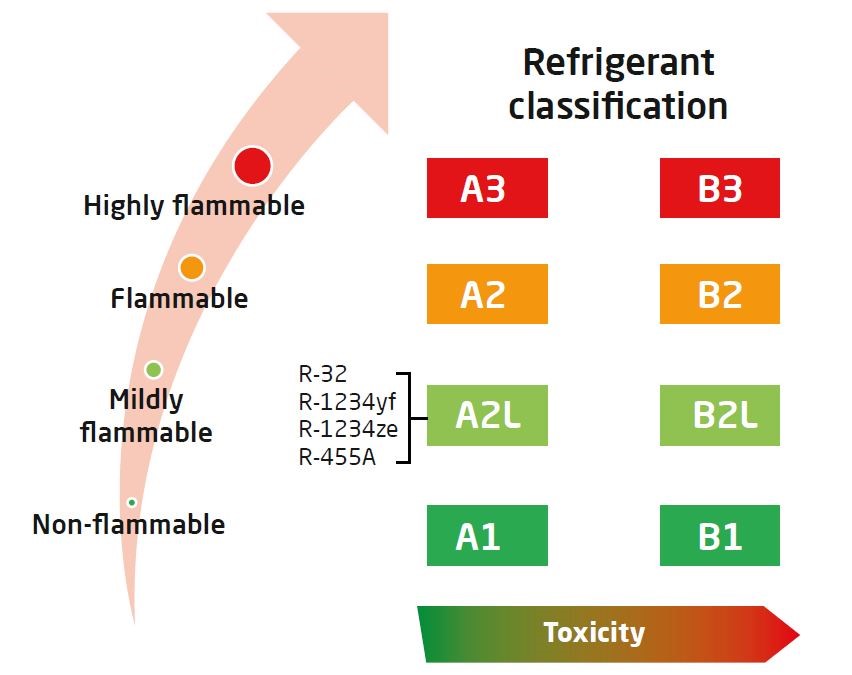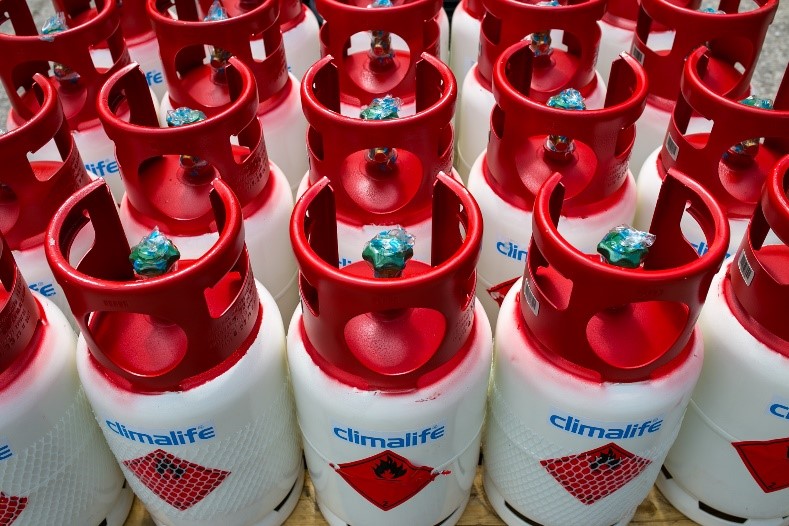The ‘F’ Word update - Neil Roberts tackles the topic of A2L Flammability
Climalife UK
Over the last year there has been an increasing interest in the very low GWP A2L refrigerants available in the market with ever increasing announcements of compliant equipment from OEMs.

Neil Roberts, Climalife Senior Technical Sales Manager discusses…
The main driver behind the development and adoption of these new refrigerants is their very low global warming potential and the increasing pressure for the GWP value to be reduced in order to meet both the F-Gas regulation and the UK carbon emissions net zero 2050 target. All refrigerants (except ammonia) have a GWP value which is relative to carbon dioxide (GWP=1) and quantities of refrigerants are often referred to as CO2 equivalent tonnes (TCO2e) i.e. how many tonnes of CO2 would give the same climate changing effects.
By 2030 the current F-Gas Legislation effective in the UK requires the TCO2e of refrigerant being placed on the market to be reduced by 79% from the baseline figure set in 2015. To meet the phase down steps and avoid the type of market disruption witnessed in 2017, the move to low GWP products needs to gather pace and will undoubtedly require the greater use of A2L refrigerants.
The very low GWP A2L refrigerants need to be used in new equipment and many compressor and component manufacturers have already placed suitable equipment on market, easing the path to choosing A2L refrigerants.
So, if the products are available and equipment is also available then why aren’t we all using A2L’s straight away? Well, a big part of this is where the ‘F’ word comes into it – Flammability.
The A2L Classification – What it means
Many of the very low GWP refrigerants available have a degree of flammability, but at a lower level of risk than most of the flammable refrigerants that were already in the market, and this led to the introduction of the 2L safety classification.
ASHRAE Classification

Most of the commonly used HFC and HFC/HFO blend refrigerants are classified as A1 meaning that they have very low toxicity and zero flammability.
The term A2L refers to a safety classification used for ISO 817 and ASHRAE Standard 34 for toxicity and flammability.
Toxicity is divided into two categories:
- A for lower toxicity,
- B for higher toxicity.
Whilst traditionally flammability was divided into three groups; 1, 2 and 3 where:
- 1 is essentially non-flammable,
- 2 is flammable, and
- 3 is higher flammability.
Based on several flammability parameters including Lower flammability Limit (LFL), Heat of Combustion and Burning Velocity, a new fourth flammability group, (2L) was introduced in 2014 to recognise the lower flammability of the new low GWP refrigerants.
Also sometimes referred to as “Mildly Flammable”, the 2L group have flammability properties (Table 1) making them significantly lower risk compared to an A3 refrigerant as, if an ignition were to occur, a significantly lower energy event (less damage) would result.
Table 1 - Flammability Properties of selected flammable refrigerants
In addition, the quantity of A2L refrigerant required to reach a flammable concentration is at least 7 times higher than for an A3 refrigerant and the quantity of energy required to cause an ignition is 100 - >1000 times greater. If like me you struggle to imagine what a millijoule of energy is, as a guide if you shuffle along a carpet the static electricity build up can be 10-25 mJ which is up to 100 times more energy than needed to ignite an A3 refrigerant but less than is required to ignite an A2L refrigerant. Numerous studies have been published demonstrating that many electrical components that would be an ignition source for an A3 refrigerant are not ignition sources for A2L refrigerants
Flammability – Mitigating the risks
A crucial step for achieving a level of risk that is as low as possible, is having adequate risk management in place.
In the majority of cases compliance with safety standards (e.g. EN 378) will be sufficient to ensure flammable refrigerants can be used safely and minimise the risk of a flammable atmosphere occurring. Several tools are available online (e.g. Climalife Charge Size Calculator Tool) to help users determine charge size compliance with EN 378 but users should also be aware other standards or national regulations related to flammable refrigerant usage may also exist.
A key step that has often been overlooked or trivialised in the past is the risk assessment. All applications using any refrigerant should have a valid risk assessment whatever classification the refrigerant falls into. In the UK since 2015 DSEAR (Dangerous Substances and Explosive Atmospheres Regulation) has applied to every refrigerant installation, including A1 refrigerants, and a DSEAR risk assessment has been required. Compliance with safety standards to minimise the risk of a flammable atmosphere occurring will also minimise any additional requirements from the risk assessment, although in situations where larger charge sizes are needed measures such as leak detection, alarms and additional ventilation may be required to mitigate the risk.
Even for A1 refrigerants, if you did not adhere to all of the product safety guidelines and best practices for installation and servicing, when released, they can cause safety risks. Providing the risks are understood and assessed accordingly, then installing and servicing an A2L refrigerant should require very little difference to that of an A1 refrigerant.

Training in the handling of flammable refrigerants is key
R-32 and R-1234yf are both A2L rated refrigerants and both have gained extensive traction for split AC and Car AC. In order for the uptake of A2L’s to increase, other sectors need to ensure engineers are trained to safely work with and handle flammable and mildly flammable refrigerants.
Like other new refrigerants in the past, initial problems and concerns are soon overcome as experience and knowledge is gained. There is plenty of guidance from trade bodies on handling flammable refrigerants, including advice on risk assessment, whilst EN 378 also provides guidance on charge size requirements and what can be achieved with mitigating circumstances and additional safety measures to achieve larger charge sizes.
It is critical that A2L refrigerants are only used in systems specifically designed to account for their flammability. Under PED (Pressure Equipment Directive) most A2L refrigerants will fall into higher PED categories at smaller volumes or pipe sizes which, for the majority of cases, means A2L refrigerants should never be used as a retrofit in systems designed for non-flammable refrigerants, unless the system has been thoroughly assessed and deemed safe for use with a flammable refrigerant.
Future Steps
Understandably, the word ‘flammable’ is bound to create a level of unease for some people, but what is important is to look beyond this and really evaluate what it means in practical terms for the industry and the F-Gas phase down.
Over the coming years the F-Gas phase down steps reduce the quantity of F-Gas (in TCO2e) placed on the market by >50% of the 2021 figure. In order to meet this it is essential that the industry continues to move to refrigerants with a much lower GWP, and to avoid any market disruption due to availability of higher GWP refrigerants, the move to low GWP refrigerants needs to be planned well before the shortages occur. That means now!
There are a number of studies that have been published which show that A2L refrigerants are more energy efficient than the other low GWP technologies. With refrigeration and air conditioning equipment attributed to consuming 17% of total electricity demand, energy efficiency is going to be a very key topic over the coming years in the climate change debate as we move to a carbon neutral economy.
A2L refrigerants will be key in the quota management process as the full effects of the HFC phase down begin to be felt. If best practice, good guidance, regulations and standards are followed when handling and installing A2L refrigerants, then there is no reason as to why A2L refrigerants cannot be used safely and easily in a large range of applications.
Want to ask Neil a technical question about A2L's?
Drop us an email at climalife.uk@climalife.dehon.com.
CHECK OUT THE CLIMALIFE A2L CHARGE CALCULATOR
We care for our customers, people, products and planet.


